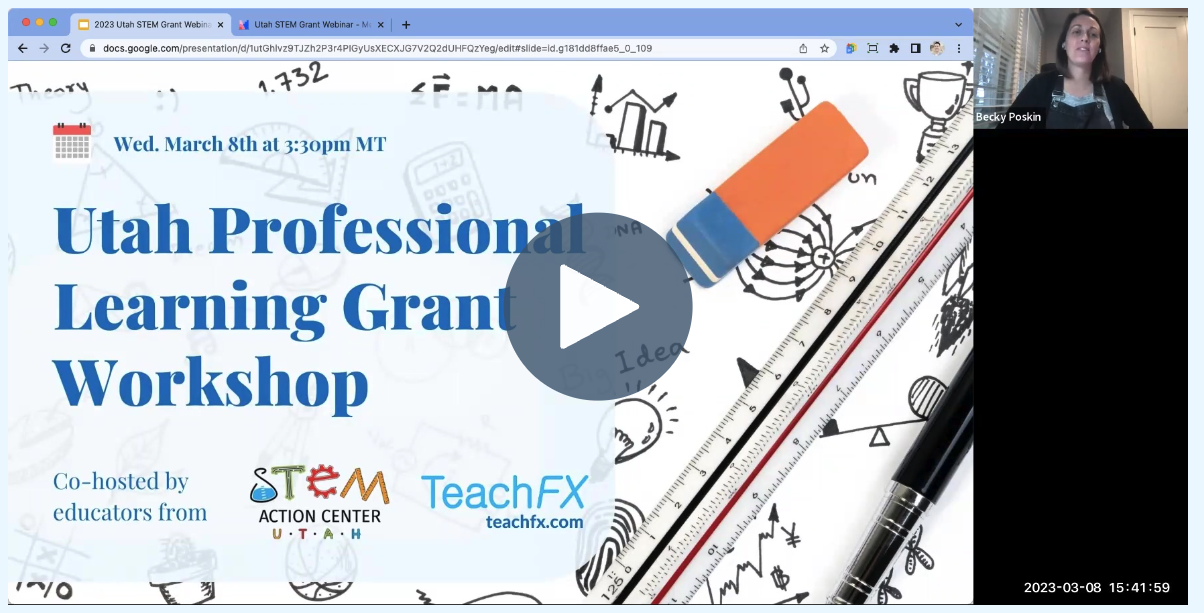Utah STEM Action Center Grant Applications Due 3/31
The Utah STEM Action Center's grant program supports thousands of Utah's teachers with valuable curricula and teaching practices. Their grants provide schools and districts with funding support for instructional coaching, mentoring, self-reflection, and effective professional learning communities (PLCs).
And applications for the STEM Action Center's Professional Learning grant are due March 31st. (Here are the details about the grant.)
Utah STEM Action Center grants will provide millions in funding – and support your program for two years.
This program focuses on locally-identified needs associated with STEM learning for K-12 teachers.
These efforts connect thousands of teachers to opportunities to create valuable STEM-based curricula and teaching practices. Funded activities include coaching, mentoring, self-reflection, off-contract work, and effective professional learning communities (PLCs).
All proposals must align with the legislative definition of effective professional learning, including taking place in learning communities, build leadership capacity in teachers, be based on data-based decision making, and support long-term change with ongoing learning opportunities. These programs include the creation of a 2 year implementation plan.
Applications can be submitted by either a single school or a group of schools but must be submitted by an administrator. These grants are also available to support informal educators, such as educators at museums, zoos, and other organizations that support STEM education in classrooms and outside of schools.
Eligibility and Timeline:
Organization leadership may apply for this grant on behalf of their educators.
Applications are due: March 31, 2023
Grants are for a two-year cycle, and will not be open again for application until February 2025
Wondering what type of project you might submit for an application?
One innovation The STEM Action Center strongly recommends for your grant application is a project with TeachFX.
TeachFX pairs discourse-focused professional learning workshops with a unique and innovative app for teachers. The app, developed by an education research team from Stanford University, uses voice AI to automatically surface insights from a teacher's own classroom.
Teachers get objective data and insights about a range of things, including discourse dynamics, lesson design, and high-leverage teaching practices like the use of open-ended questioning, wait time, and teacher uptake of student contributions. Hear our educator’s stories.
Independent Research Supporting the TeachFX Impact
The insights TeachFX surfaces for teachers have proven extremely effective in large scale research trials.
And TeachFX has been implemented with impressive results in schools and districts across the country, including in Utah’s Jordan School District, where math teachers are working with TeachFX to increase equitable mathematical discourse.
With STEM Action Center grants and TeachFX, teachers throughout Utah have improved teaching and learning….
➡️ 1,000+ STEM teachers using TeachFX to improve academic dialogue
➡️ 33% increase in student talk
➡️ 116% increase in open-ended questions
If your teachers might benefit from this grant, we'd like to help!
Utah STEM Action Center's grant program supports thousands of Utah's teachers with valuable curricula and teaching practices.
Don’t miss this chance to expand your PD program with funding support for instructional coaching, mentoring, self-reflection, and effective professional learning communities (PLCs).
Would you like personalized guidance to complete your grant application before the due date?
Watch the replay of our recent workshop with the STEM Action Center, TeachFX, and other Utah educators interested in applying for the grant. Or book your own time with us to receive personalized guidance to complete your grant application before the due date.


